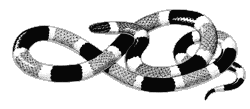Sonoran Coral Snake
(Micruroides euryxanthus)
Order: Squamata
Family: Elapidae (fixed front-fang venomous snakes)
Other common names: Western Coral Snake
Spanish name: corallilo
Distinguishing Features
The Arizona coral snake is a slender, small snake reaching only 13 to 21 inches (33-53 cm) in length. It is brightly colored with broad alternating bands of red and black separated by narrower bands of bright white or yellow. The bands completely encircle the body, but are paler on the belly. The head is black to behind the eyes. The snout is blunt.

Range
The Arizona coral snake is found in central and southern Arizona, extreme southwestern New Mexico and southward to Sinaloa in western Mexico.
Habitat
This snake occupies arid and semiarid regions in many different habitat types including thornscrub, desert-scrub, woodland, grassland and farmland. It is found in the plains and lower mountain slopes from sea level to 5800 feet (1768 m); often found in rocky areas.
Life History
Carnivorous, as are all snakes, the Arizona coral snake specializes in feeding primarily on blind and black-headed snakes. Occasionally it eats lizards or other small, smooth-scaled snakes. A secretive snake, it usually emerges after sundown, and may remain active well into the night. It is also frequently active during the day after rains or if the sky is overcast. If disturbed it will bury its head in its coils, elevate and wave its tightly coiled tail, and evert its anal lining, making a popping sound. Two to 3 eggs are laid during the summer.
Comments
The venom of this snake is similar to that of the cobra. However, due to the small size of the snake (less venom), smaller mouth, and small fangs (less effective means of delivery), the venom does not pose as much danger to humans as that of rattlesnakes. As with any venomous reptile, medical attention should be sought in the event of a bite.
Many people use a rhyme to remember the coral snake: “Red touch yellow, harmful fellow.” Unfortunately, this rhyme does not always work in our region (and many parts of the western hemisphere). We have several non-venomous snakes in our region that have red bands touching yellow bands. The best way to identify a coral snake is by: 1) a very blunt head that is black to behind the eyes, and 2) bands that completely encircle the body, along with the yellow or white bands occurring on both sides of the red bands.










